Key Takeaways
-
- Organizational change management models and methodologies are typically high-level roadmaps designed to help steer change leaders and practitioners through complex change projects.
-
- The distinction between change management models and methodologies is important, with models offering a structured approach to managing change, while methodologies provide more detailed guidance and resources.
-
- Popular change management models and methodologies include Kotter’s 8-Step Process, Prosci ADKAR Model, and Lewin’s Change Management Model.
-
- Customizing and implementing models and methodologies effectively is crucial for addressing unique organizational needs and ensuring a successful change management process.
As a change management professional, navigating organizational transformation can be complex and turbulent. That’s why it’s important to have a solid grasp of the different change management models and methodologies that are available.
These models provide a roadmap to guide you through the different stages of the change management process, ensuring that your organization remains resilient and adaptable in today’s fast-changing business landscape.
In this article, we’ll explore the most widely-used organizational change management models and methodologies, delve into their key principles and applications and help you determine which approach is best suited to your organization’s specific needs and goals.
Whether you’re a seasoned change management practitioner or new to the field, this article aims to equip you with the knowledge and insights necessary to select and implement the right change management model or methodology for your change project.
Change management model vs. change management methodology
Understanding the distinctions between change management models and methodologies is essential for choosing the right approach to guide your organization through a successful change initiative.
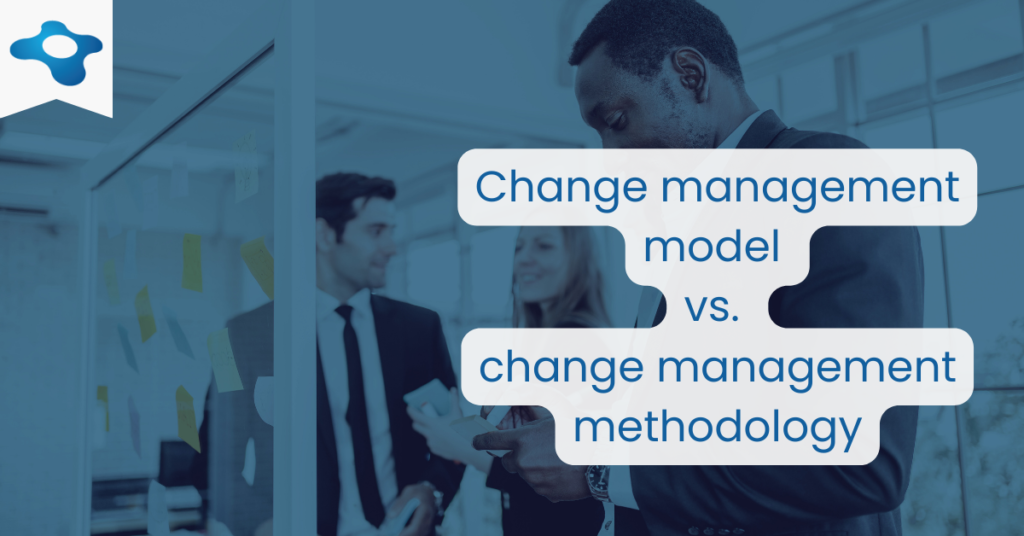
Let’s define and explore the differences between these two key concepts.
Definition of Change Management Model
-
- A change management model is a conceptual framework that outlines the stages, steps, or phases of the change project. It provides a high-level understanding of how to approach change, offering structure and guidance for managing organizational transformations.
-
- The purpose of models and frameworks in change management is to simplify complex change initiatives by breaking them down into more manageable components. These models offer change managers a visual representation of an overall path to change, helping them anticipate potential challenges and implement best practices at each stage.
Definition of Change Management Methodology
-
- A change management methodology is a more comprehensive, detailed, and prescriptive approach to managing change. It specifies the processes, roles, and deliverables required to successfully execute a change initiative.
-
- Methodologies guide the overall change management process by providing a systematic and structured approach, ensuring that each aspect of the change initiative is effectively managed, monitored, and aligned with the organization’s objectives.
To illustrate the difference between a model and a methodology, let’s consider Changemethod as an example – it comprises three core types of content: processes, roles, and deliverables, as depicted in the ‘methodology triangle’:

-
- Processes define what you need to do and how to do it. Processes require the skills of Roles. Processes result in Deliverables.
-
- Roles tell you who needs to do what. Roles perform Processes. Roles create Deliverables.
-
- Deliverables are what is produced. Deliverables require the skills of Roles. Deliverables are created as a result of Processes.
By contrast, a change management model would provide a high-level overview of the stages or steps involved in a change initiative, without delving into the specific processes, roles, and deliverables required for successful implementation.
Popular Change Management Models
A number of change management models and methodologies have evolved over time, each with its unique approach to guiding organizations through change.
Let’s now explore some of the most popular and widely-used models and methodologies, along with their key components and benefits.
Lewin’s Change Management Model

-
- Developed by psychologist Kurt Lewin, this classic model simplifies the change process into three stages: Unfreeze, Change and Refreeze. The model emphasizes the need to challenge existing beliefs and behaviors (Unfreeze), introduce and embrace new ways of working (Change), and solidify the new state (Refreeze).
-
- The applicability and benefits of using this model include its simplicity, which makes it easy to understand and communicate. It also highlights the importance of creating a supportive environment for change, addressing both emotional and practical aspects of the process.
Kotter’s 8-Step Change Management Model

-
- Developed by Harvard Business School professor John P. Kotter, the 8-Step Process is a well-known model that breaks down change into eight actionable steps. The steps are: (1) Create a sense of urgency (2) Form a powerful coalition (3) Create a vision for change (4) Communicate the vision (5) Remove obstacles (6) Generate short-term wins (7) Consolidate gains (8) Anchor the change in the corporate culture.
-
- The benefits and applications of this model include its clear, sequential structure and focus on both short-term and long-term goals. It emphasizes the importance of communication, collaboration, and continuous improvement throughout the change process.
McKinsey 7S Change Management Model
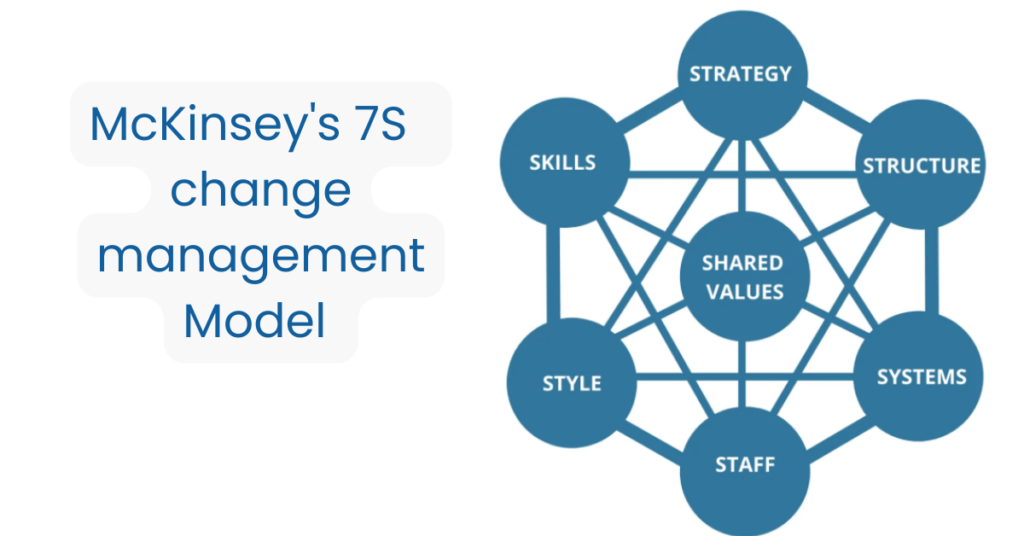
-
- The McKinsey 7S Framework is a strategic management tool that identifies seven interrelated elements critical for organizational success: Strategy, Structure, Systems, Shared Values, Skills, Style and Staff. By analyzing and optimizing these elements, organizations can create a more cohesive and effective approach to change management.
-
- This framework supports change management initiatives by providing a holistic view of the organization and emphasizing the need for alignment among all elements. By identifying gaps and areas of improvement, organizations can better target their change efforts and create more sustainable outcomes.
Prosci’s ADKAR Change Management Model
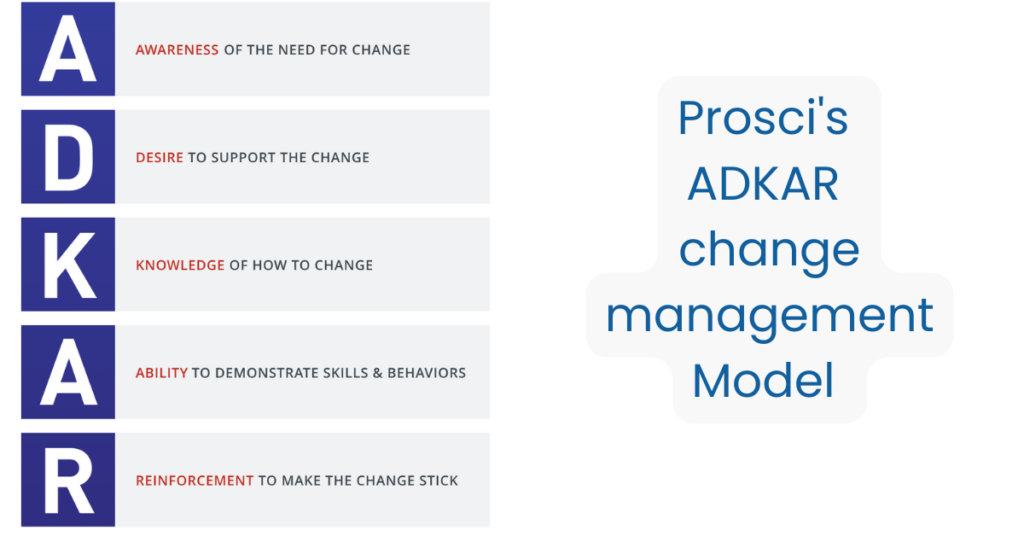
-
- The Prosci ADKAR Model is a goal-oriented methodology that focuses on individual change to drive organizational change. The acronym ADKAR stands for Awareness, Desire, Knowledge, Ability and Reinforcement, representing the five sequential building blocks needed for successful change.
-
- The advantages and use cases of this methodology include its emphasis on individual change, which allows organizations to better understand and address employee resistance. It also provides a clear roadmap for managing the human aspects of change and can be applied to various types of change initiatives.
Changemethod’s Change Management Model

-
- Changemethod is a change management methodology that helps plan, implement, and sustain change in organizations. It is built around six areas of best practice are: (1) Shared Change Purpose (2) Visible Change Leadership (3) Smart Engagement and Communication (4) Strong Individual Performance (5) Supportive Organization and Culture (6) Meaningful Change measurement.
-
- These six areas of best practice cascade out – and interlink with – 18 change management roles, 21 process guides and 100+ diagnostic, planning and implementation tools and templates.
-
- The methodology is designed for change leaders, change managers and practitioners, project managers, business managers, consultants, teachers, and students. Changemethod can be used for any size of change project, scalable to fit larger or smaller projects based on the dimensions of breadth, depth, impact, and criticality of the change
Selecting the right change management model or methodology
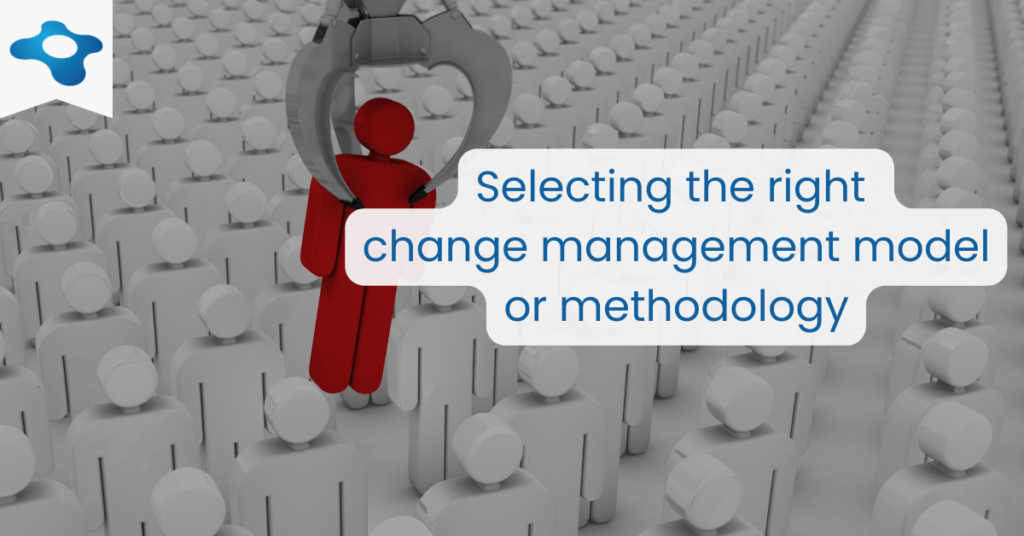
Assessing Organizational Needs
-
- To choose the most appropriate model or methodology for your organization, start by evaluating your organization’s specific change requirements. Consider factors such as the scope of the change, the desired outcomes, and the potential impact on employees and stakeholders.
-
- By identifying your organization’s unique needs, you can better determine which model or methodology will best support your change management efforts and help you achieve your goals.
Evaluating Model/Methodology Suitability
-
- When selecting the right change management framework consider criteria such as ease of implementation, adaptability, and compatibility with your organization’s culture, size, and complexity.
-
- Research the various models and methodologies available, taking into account their strengths and weaknesses, and assess how well they align with your organization’s needs and objectives. This will help ensure that your chosen approach will effectively support your change initiatives.
Integrating Multiple Models/Methodologies
-
- In some cases, you may find it beneficial to combine different models or methodologies for a more tailored approach to change management. This can provide a more comprehensive solution that addresses the unique challenges and opportunities of your organization.
-
- To successfully integrate multiple models or methodologies, identify the most valuable elements of each and ensure they complement one another.
-
- Be mindful of potential conflicts or redundancies, and make adjustments as needed to create a cohesive and effective change management strategy. Consider using the change curve to understand stakeholders’ individual journeys and anticipate potential resistance.
Case Study: High Growth Software and Services Firm
-
- A high-growth software and services firm faced the challenge of implementing a new organizational structure to accommodate its rapid expansion.
-
- To effectively manage this change, they assessed their organizational needs and selected a combination of change management models and methodologies that best fit their unique requirements.
-
- By adopting a customized approach, the firm focused on addressing the specific change-related needs of their organization, such as leadership buy-in, employee engagement, and clear communication of the new structure. They also utilized various tools and templates from Changemethod to diagnose, plan, and implement the change effectively.
Implementing Change Management Models on Your Change Project

Gaining Leadership Support
The success of implementing change management models and methodologies in your organization largely depends on the commitment and support from leadership.
Leadership buy-in is crucial as it helps drive the change, allocate resources, and set the tone for the rest of the organization. To engage leaders and secure their commitment, consider the following strategies:
-
- Clearly communicate the benefits of the chosen model or methodology and how it aligns with the organization’s strategic objectives
-
- Involve leaders in the decision-making process, ensuring their input and concerns are demonstrably taken into account
-
- Share progress updates and milestones to maintain transparency and demonstrate the positive impact of the change initiative
Training and Capacity Building
Developing the skills and capabilities of your employees is essential for effectively implementing your chosen change management frameworks.
Providing training resources and opportunities helps staff understand the new approach and equips them with the knowledge to successfully navigate change. Consider the following steps:
-
- Conduct workshops, seminars or e-learning courses tailored to the specific model or methodology being implemented
-
- Leverage resources from Changemethod to provide practical tools and templates for employees to apply in their day-to-day work
-
- Establish a mentorship or coaching program that allows experienced employees to support and guide others through the change project
Monitoring and Adjusting the Implementation
Continuous evaluation of the progress and effectiveness of your selected model or methodology is key to ensuring a successful change initiative.
Regular monitoring enables your organization to identify areas of improvement, address challenges, and make data-driven decisions.
Keep in mind the following points:
-
- Establish key performance indicators (KPIs) and milestones to track the progress of the change initiative
-
- Solicit feedback from employees and stakeholders to gain insights into the impact of the change and identify potential areas for improvement
-
- Adjust the approach as needed based on the feedback and results, ensuring that the change initiative remains relevant and effective in achieving its objectives
Case Study: fintech subsidiary of financial services firm
-
- A fintech subsidiary of an established financial services firm recognized the need for a significant organizational change to remain competitive and innovative in the rapidly evolving market.
-
- They chose to implement a combination of change management models and methodologies to drive their transformation.
-
- To ensure a successful implementation, the company gained leadership support by presenting a clear vision and strategic alignment with the parent company’s objectives. They also emphasized the benefits of adopting a more agile and customer-centric approach. Leadership buy-in facilitated the allocation of necessary resources and helped set the tone for the organization
Changemethod: Off-the-Shelf, Customizable Model and Methodology
-
- Changemethod is a comprehensive change management methodology that supports organizations in implementing successful change projects and programs. It is designed to align with various change management models and methodologies, offering a flexible and customizable approach.
-
- By providing over 100 tools and templates for diagnosing, planning, and executing change projects, Changemethod ensures change practitioners have access to a complete suite of resources to help drive successful change initiatives.
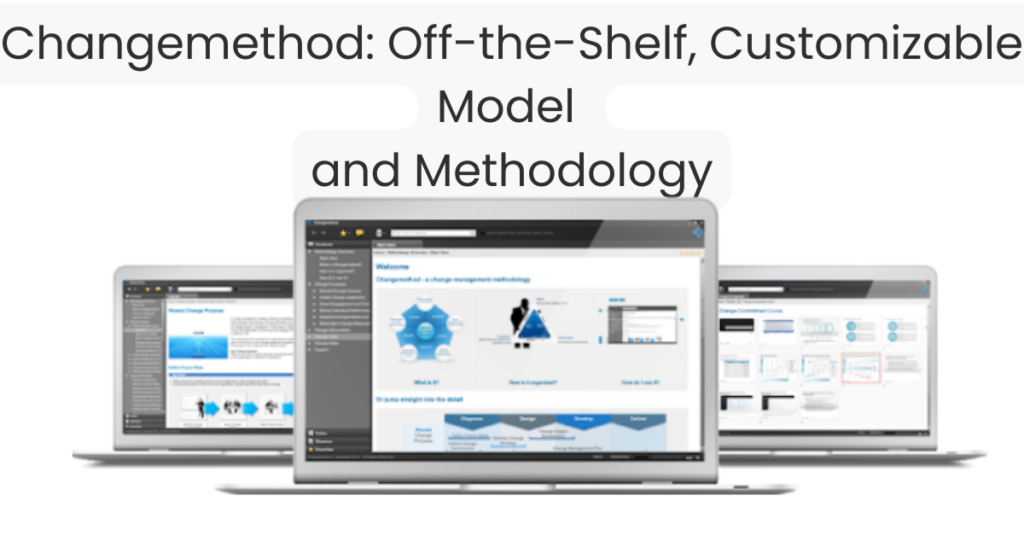
Customization and Adaptability
-
- One of the key strengths of Changemethod is its adaptability. Its tools and templates can be easily customized to fit the specific needs of different organizations and change projects, regardless of the model or methodology being used.
-
- This flexibility ensures that change practitioners can effectively tailor their approach to the unique requirements of their organization and change project, ultimately leading to more successful outcomes and a smoother change management process.
FAQ on Change Management Models and Methodologies

What is the difference between a change management model and a methodology?
A change management model provides a high-level framework that outlines the key stages or elements of managing change, while a methodology is a more detailed approach that specifies the processes, roles, and deliverables required to successfully implement change.
Models offer a structured way of thinking about change, while methodologies provide a step-by-step guide for executing change initiatives.
How do I choose the right change management model or methodology for my organization?
To select the most suitable model or methodology, consider factors such as your organization’s culture, size, and complexity, as well as the specific change objectives and requirements.
Evaluate different models and methodologies based on these criteria, and engage with key stakeholders to gain their input and ensure alignment with organizational needs.
Can I use multiple change management models or methodologies simultaneously?
Yes, absolutely.
It is possible to combine different models and methodologies to create a tailored approach that addresses the unique needs of your organization and change project.
By integrating elements from various models and methodologies, you can develop a more comprehensive and flexible change management strategy.
How can Changemethod support my organization in implementing change management models and methodologies?
Changemethod is a flexible and customizable change management methodology that can align with various models and methodologies.
It provides over 100 tools and templates for diagnosing, planning, and executing change projects, allowing change practitioners to tailor their approach to the specific needs of their organization and chosen model or methodology.
How do I ensure the successful implementation of a chosen change management model or methodology?
To maximize the chances of successful implementation, secure leadership buy-in, develop the necessary skills and capabilities among employees and continuously monitor and adjust your approach based on feedback and results.
Engaging stakeholders, offering training resources, and adopting a flexible, adaptable mindset will further enhance the effectiveness of your chosen model or methodology.





